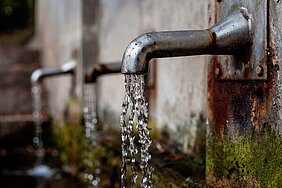The new EU Drinking Water Directive calls for increased resource protection and risk management in the catchment area of drinking water abstraction. How can this be implemented in German legislation? Together with the drinking water supplier bnNETZE GmbH, we are investigating this question in our new joint project ResiTrink!
The new EU Drinking Water Directive, which came into force in January 2021, strengthens resource protection in water supply and introduces risk management - also in the catchment area - as a mandatory element. The main goal of the risk-based approach in water supply is to prevent impairments of water quality and thus to increase the security of supply.
bnNETZE and TZW have been conducting a three-year project since May 2022, focusing on testing the implementation of risk management in accordance with the new EU Drinking Water Directive. The goal is to create new synergies between water and resource protection and to strengthen existing synergies. Using the example of a bnNETZE waterworks, a methodology for interlinked risk management from the catchment area to the delivery of drinking water to the consumer is being developed and tested. In the process, novel procedures and sample processes are being developed and interfaces identified in order to optimally involve the authorities involved and ensure the necessary exchange of data and information.
Pilot practical experiences in this regard are extremely valuable, especially at this point in time, since the implementation of the EU Directive into national law is imminent and many questions, e.g. with regard to the interfaces between catchment area and water supply as well as to the cooperation/data exchange between authorities and water supply companies, have not yet been clarified. During the transition period until the obligatory first implementation of risk management, valuable experience can be gained from corresponding projects, which can have a far-reaching influence.
One focus of the project is on taking regional conditions into account in order to develop methods that optimally use or expand the synergies of resource protection and general water protection. In this way, the project is to make a contribution to enabling close integration with general water protection in further projects on risk management in water supply in the region. Through a joint objective of various regional actors, the greatest possible benefit for the sub-sectors concerned is to be achieved.

![[Translate to English:] Prüfstelle-Produktprüfung_Teststand Test centre and product testing](/fileadmin/_processed_/0/9/csm_TZW-Karlsruhe_Pruefung_Geraete-Teststand_377188946c.jpg)



























